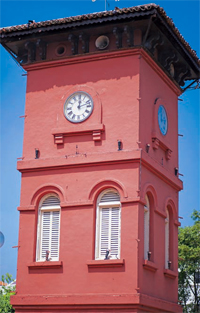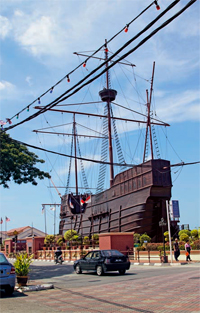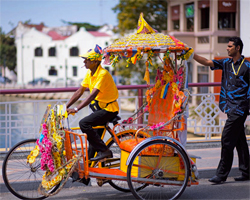MELAKA IS A HISTORICAL JEWEL IN MALAYSIA’S CROWN, AND HUGH UJHAZY TAKES A LOOK AT THE PEOPLE AND EVENTS THAT SHAPED THE ARCHITECTURE OF THIS CHARMING CITY.
 European palates came late to spice. Though evidence of the spice trade can be traced as far back as Roman times, the flavors well known to Indian, Arabian, and Chinese tongues were foreign to most Europeans until late in the Middle Ages. Overland routes brought pepper, cardamon, cinnamon, and other exotic seeds and pods to Europe via Venice. Such routes were lengthy, dangerous, and expensive. The prices commanded by pepper and the monopoly held by Venice were major inducements to opening a sea route to India and, ultimately, Asia.
European palates came late to spice. Though evidence of the spice trade can be traced as far back as Roman times, the flavors well known to Indian, Arabian, and Chinese tongues were foreign to most Europeans until late in the Middle Ages. Overland routes brought pepper, cardamon, cinnamon, and other exotic seeds and pods to Europe via Venice. Such routes were lengthy, dangerous, and expensive. The prices commanded by pepper and the monopoly held by Venice were major inducements to opening a sea route to India and, ultimately, Asia.
THE EUROPEAN RACE FOR MELAKA
Once the destination was known, all that was needed was to run the race. The Portuguese made the first parlays into the unknown realms of the Far East, landing outposts in India initially, before the fleet of Alfonso d’Albequerque, the Portuguese Viceroy of India, set foot on the port of Melaka. Other colonial masters followed, including the Dutch and the British.
Sheltered from the open ocean by the embrace of the Malay Peninsula on one side and the islands of Indonesia on the other, the long shallow waters of the Straits of Malacca gave welcome respite from the rigors of ocean travel.
Melaka dominated trade during the time of the Portuguese, and marked the point of Dutch dominance in the Far East, along with Batavia (now Jakarta) in Indonesia. During the time of the British colonisation of Malaya, Melaka and George Town became major colonial sites. Both cities bear the marks of colonial occupation in their streets, buildings and culture.
Portuguese writer Barbarosa wrote “Whoever is Lord in Malacca has his hand on the throat of Venice.” It was a major port along the spice route, and its harbour bristled with the sails and masts of Chinese junks and spice-laden vessels from all over the hemisphere, but Melaka existed well before the first European eyes sighted the masts of Indian, Arab, and Chinese traders.
BEGINNINGS
 Established around 1400 as a small fishing village, by the early 1500s, Melaka was the thriving center of the Malay Sultanate. At the time of its fall, the Malay Sultanate, which lasted for a little more than a century, housed over 100,000 people in residential areas connected over the river by a stone bridge. The city was walled-in, with four entry gates each marked by watch and drum towers, and throughout the night a man would patrol the streets with hand-bells.
Established around 1400 as a small fishing village, by the early 1500s, Melaka was the thriving center of the Malay Sultanate. At the time of its fall, the Malay Sultanate, which lasted for a little more than a century, housed over 100,000 people in residential areas connected over the river by a stone bridge. The city was walled-in, with four entry gates each marked by watch and drum towers, and throughout the night a man would patrol the streets with hand-bells.
By the mid-15th century, Melaka controlled most of the southern Malayan Peninsula and the spice trade, and was instrumental in propagating Islam throughout Southeast Asia as far as Thailand.
The city of Melaka was a cosmopolitan port where almost 80 languages were said to have been spoken. The port welcomed Tamil, Arab, Persian, Javanese, and Chinese traders, and each ethnicity had their own quarters: Bukit Cina for the Chinese and Kampong Kling, for the “Kling” or South Indians.
Because the city was originally built of wood, there are no crumbling and stately reminders of the power once wielded by the Melakan Sultanate, but along the shores of the Melaka River, the scene has changed little over the last four centuries.
Sloping rooftops of traditional Malay houses still hang over the water, and seem to call out sleepily from the past; the riverside is a part of the city that seems to have defied the Portuguese.
CRAFTED BY VISITORS
The Portuguese influence is visible in the city’s architecture and they, as in their other colonies, taxed buildings relative to their width; a policy that accounts for the deceptively thin facades along the colonial streets. A building no more than 12 feet across can easily extend backwards 200 feet, its hidden interior a linear succession of high-ceilinged rooms and courtyards.
On the streets themselves, however, it is the Chinese influence that is felt most. Open-air fruit, vegetable, and fish markets sing with cadences of people bargaining in Mandarin. On the edge of the city is the largest Chinese graveyard outside of China itself, a sprawling zone of fields, trees, and uterus-shaped tombstones.
 Reflecting an eclectic population base and as a display of wealth at the zenith of the sultanate, the sixth sultan, Mansur Shah (1456-77) is said to have built an ornate palace at the foot of Melaka Hill. Comprised of seven stories supported by thick round columns, its windows were decorated with gold leafing and giant Chinese mirrors. The building was surmounted by a copper and tin Minankabau roof topped with a red glass orb that blazed in the sunlight, or so the story goes; the palace is long gone.
Reflecting an eclectic population base and as a display of wealth at the zenith of the sultanate, the sixth sultan, Mansur Shah (1456-77) is said to have built an ornate palace at the foot of Melaka Hill. Comprised of seven stories supported by thick round columns, its windows were decorated with gold leafing and giant Chinese mirrors. The building was surmounted by a copper and tin Minankabau roof topped with a red glass orb that blazed in the sunlight, or so the story goes; the palace is long gone.
Under the Portuguese and the colonialists that followed, Melaka was laid out in clearly aligned streets punctuated by open squares. The Portuguese converted the city into a Christian fortress town characterised by the keep of A’ Famosa within the walls that also enclosed several chapels, a monastery, two hospitals, two palaces, and five churches, one of which was built with the stones of Muslim tombs.
Avoiding timber for construction, the Portuguese built in masonry, particularly laterite, a red clay found locally. Sadly, all that remains today of Portuguese Melaka is the Santiago Gate, which stood at the base of A’ Famosa.
The Christ Church, built by the Dutch in 1753, sports a rich red colour and has a robust, rectangular plan without aisles, the whole structure being covered with a flat timber ceiling supported by beams cut from a single tree.
When the British took over control of the city at the turn of the 19th century, they demolished the Portuguese fortress and incorporated Melaka into the Straits Settlements along with Singapore in 1824. Under the British, a revival in the tin and rubber trade could be seen in the wealth of the villas that lined the streets of Melaka.
UNCHANGING FACE OF THE CITY
The heart of Melaka is its river. The successive administrative centres of Melaka have always resided on the left, or east, bank of the river. Though inhabited by waves of Portuguese, Dutch, and British occupiers, the overall character of the area of Melaka on the west bank of the river is dictated by a Chinese influence. Two parallel streets on this bank, which retain their Dutch names of Heeren and Jonker Streets, are mostly occupied by Chinese shophouses, each with one door and two windows. Some of these shophouses still retain elements of their delicately carved craftsmanship, and continue to display half-shutters on their doors.
Melakan mosques are distinctive and can be seen in the older sections of the city. This building, based on a square plan, is surmounted by a two or three tired pyramidal roof covered with tiles. Detailing belies Chinese influence, and the accompanying minarets similarly resemble a pagoda or stupa-like form embellished with Renaissance arches and embedded columns. Two such mosques, some of Malaysia’s oldest, can be found in the Chinese quarter of Melaka: Masjid Kampung Hulu (1728) and Masjid Kampung Kling (1748).
Melaka was declared a UNESCO World Heritage site in 2008 along with George Town in Penang. As UNESCO notes in declaring the importance of both sites:
“With its government buildings, churches, squares, and fortifications, Melaka demonstrates the early stages of this history originating in the 15th-century Malay sultanate and the Portuguese and Dutch periods beginning in the early 16th century. Featuring residential and commercial buildings, George Town represents the British era from the end of the 18th century. The two towns constitute a unique architectural and cultural townscape without parallel anywhere in East and Southeast Asia.”
Melaka, just 90 minutes’ drive from downtown Kuala Lumpur, is an easy and rewarding day trip.
This article was written by Hugh Ujhazy for Senses of Malaysia.
Source: Senses of Malaysia July-Augt 2012
Click here for your free print subscription and free delivery of The Expat.
"ExpatGo welcomes and encourages comments, input, and divergent opinions. However, we kindly request that you use suitable language in your comments, and refrain from any sort of personal attack, hate speech, or disparaging rhetoric. Comments not in line with this are subject to removal from the site. "

















